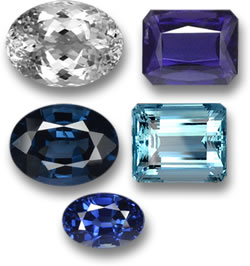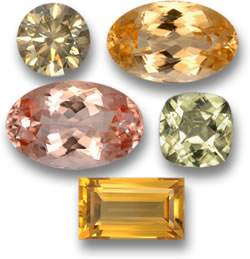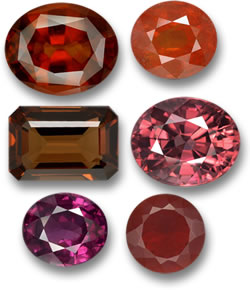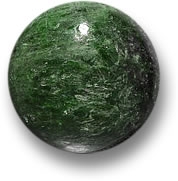|
Reviewed By Andreas Zabczyk
Untreated Gemstones for Jewelry
Untreated Topaz, Iolite, Spinel, Aquamarine and Sapphire Gems
The treating of gemstones to enhance color, clarity and durability is becoming more and more common. It can be surprising for many consumers to discover that many gem enhancements are actually considered to be 'routine', especially for gemstones that are specifically sought after for the manufacturing of jewelry. Believe it or not, the most commonly enhanced varieties of gemstones also happen to be some of the most valuable as well, including sapphire, ruby, emerald and diamond. The primary reason for this is lack of availability because let's face it, natural gems are indeed a rarity which is why they have been prized for thousands of years. Without gem enhancements, many gem varieties wouldn't even exist today. For example, almost all of the world's emeralds used for the manufacturing of jewelry are clarity-enhanced through a process known as oiling. Oiling is just one of the many gem treatment methods used today when it comes to fracture filling. Most ruby and sapphire are routinely heated to improve clarity or color, and often times they may be heated with a substance such as beryllium or iron to alter color. As long as gem treatments are openly disclosed by suppliers, there is nothing unscrupulous about the buying and selling of treated gemstones, especially since treated gems are much more affordable than untreated gems and by appearance alone, the difference is almost impossible to detect. Many gem treatments are intended to enhance color and clarity, while other enhancements are made to increase hardness and durability, transforming fragile, unattractive and otherwise unsalable material into more durable and attractive gemstones that are suitable for jewelry. Many people still prefer to buy completely untreated gemstones. Even for the most expert buyers, determining whether a gem has been enhanced is not always easy and will usually require much more than just a jeweler's loupe. Even with the use of advanced gemological equipment, many gem treatments can be almost impossible to detect. So for many gem and jewelry buyers, the best way to ensure they're acquiring only untreated gemstones is through buying certain gemstone varieties that for the most part are never treated or enhanced in any way. 
Untreated Diamond, Imperial Topaz, Morganite, Diaspore and Citrine Gems
If you're searching for untreated gemstone options, you may be surprised to discover that there are actually over 100 different gem types to be considered, from A (agate) to Z (zircon). Although this is not a comprehensive list, it should provide a good start. Starting with the beryl group of gems, there are several different varieties that are almost never enhanced, unlike emerald, which is the best-known beryl gemstone. Other, lesser-known varieties of beryl such as aquamarine, goshenite and morganite are usually never treated. Aquamarine is sometimes heated to enhance its color or clarity, but most aquamarine is completely unenhanced. Aquamarine colors can range from pale blue to bluish-green, and can often be found with cat's eye chatoyancy. The light pink to peachy colored beryl known as morganite is also usually found completely untreated, as well as colorless beryl, which is known as goshenite. Large, high quality aquamarine gems can be rather expensive, but smaller to medium-sized aquamarine gems are rather affordable, especially when compared to the prices of emerald. Goshenite and morganite are also often available in very large sizes and both are known to exhibit excellent clarity and transparency. The chrysoberyl family of gemstones also includes a few different untreated gemstone varieties. The most famous chrysoberyl is the chatoyant cat's eye variety which is cut en cabochon in order to maximize its most desirable trait. Faceted chrysoberyl is also usually untreated and can be found in several attractive hues, ranging from golden-yellow to dark-green. The rarest member of the chrysoberyl family is the color-change variety known as alexandrite. Color-change alexandrite is actually one of the rarest of all gemstones. Alexandrite is colored by chromium and depending on the type of lighting, it will appear to shift from emerald green to pink-red in color; it can be found in other color change combinations too. Alexandrite is rarely found in large sizes, especially in gems weighing over 1 carat. Even a 0.5 carat alexandrite gem is considered to be an excellent find and can easily fetch hundreds of dollars for a single stone. On the other hand, regular chrysoberyl and cat's eye chrysoberyl are both quite affordable, though they are also rarely found in large sizes. The feldspar family of gemstones includes many varieties that are very often untreated, including amazonite, orthoclase, sunstone, labradorite, moonstone and rainbow moonstone. Moonstone and rainbow moonstone are highly desired due to their amazing optical phenomena known as adularescence, while labradorite is famous for its similar color play known as labradorescence. 
Untreated Garnet, Enstatite, Zircon, Rhodolite and Fire Opal
One of the largest and most important gemstone groups includes many varieties of jewelry gemstones that are almost never treated or enhanced in any way; this is the garnet family of gems. Although traditionally known to be red, garnets can actually be found in a very wide range of colors, including golden, green and even peachy pinkish-orange. The garnet group includes many well-known gemstone varieties such as almandine garnet, pyrope garnet, rhodolite garnet and spessartite garnet. One of the rarest and most valuable garnet varieties is the golden to green color form of andradite known as demantoid garnet. Black andradite is much more common and is traded as melanite. Other well-known varieties of garnet include hessonite garnet, malaya garnet, Mali garnet and tsavorite garnet. One of the rarest members is the green garnet known as uvarovite, but because it is almost never found in sizes large enough to facet, it is usually offered only as druzy. Garnet can even be found with color-change properties. Most garnet varieties are available at very affordable prices and several garnets can be acquired in very large sizes, often weighing over 5 carats. When it comes to natural, untreated gems, the garnet group is not one to be overlooked. Almost everyone is familiar with the gemstone known as jade, but most people are unaware that there are actually several different varieties of jade used as gemstones today. Of the many varieties belonging to the jade group, only two types are classified as pure jade: nephrite and jadeite. All of the other varieties of jade are mineral compounds that consist of either jadeite or nephrite and at least one other mineral (usually more), such as omphacite, albite, feldspar or kosmochlor, for example. Jade-albite and maw-sit-sit may sometimes be mistaken for one another and both may also be referred to as chloromelanite, but technically they are not always the same. In order for jade to be called maw-sit-sit, it must come from Burma and consist of primarily jadeite and kosmochlor; whereas jade-alibite is composed of primarily jadeite and albite. Chloromelanite is a term that can be used to refer to any form of mixed jade, containing parts of jadeite along with albite, feldspar, kosmochlor and various other minerals. 
Untreated Maw-Sit-Sit from Burma
Many mixed jade gems are quite often available completely untreated, including varieties of omphacite jade, maw-sit-sit and jade-albite. Most pure jade, which includes both jadeite and nephrite, is commonly treated to enhance color or durability, but top-quality jade can still be found untreated. 'Type A jade' is a commonly used term which refers to top-quality jadeite or nephrite that has not been enhanced in any way, which includes dyeing, bleaching and impregnation. The most valuable jade is "type A jade" with an emerald-green color, known in the trade as "imperial jade". Although jade is mostly known for its green form, it is also available in a wide variety of other colors, including lavender, yellow, pink and white. Jade is an extremely tough, versatile and durable material that can be cut, shaped, carved and worked into many different designs, making it possible to find a jade gem to suit everyone's style. At the current time, we have over 30,000 untreated gems available in our inventory. So although we have a large selection of gems that have been enhanced, we still carry more untreated colored gemstones than any online gemstone supplier specializing in only untreated gems. If you are interested in untreated gems, we are likely to have something suitable for you. Since there are many more untreated gem types to choose from than those listed above, we will continue to discuss more untreated gemstone jewelry options. We hope that the above will help provide a good place to start when it comes to sourcing the finest gems that are 100% natural and completely untreated. This Page in Other Languages
|
| STAY IN TOUCH | NEWSLETTER |
| *You're signing up to receive GemSelect promotional email. |
Copyright © 2005-2024 GemSelect.com all rights reserved.
Reproduction (text or graphics) without the express written consent of GemSelect.com (SETT Company Ltd.) is strictly prohibited.
2607